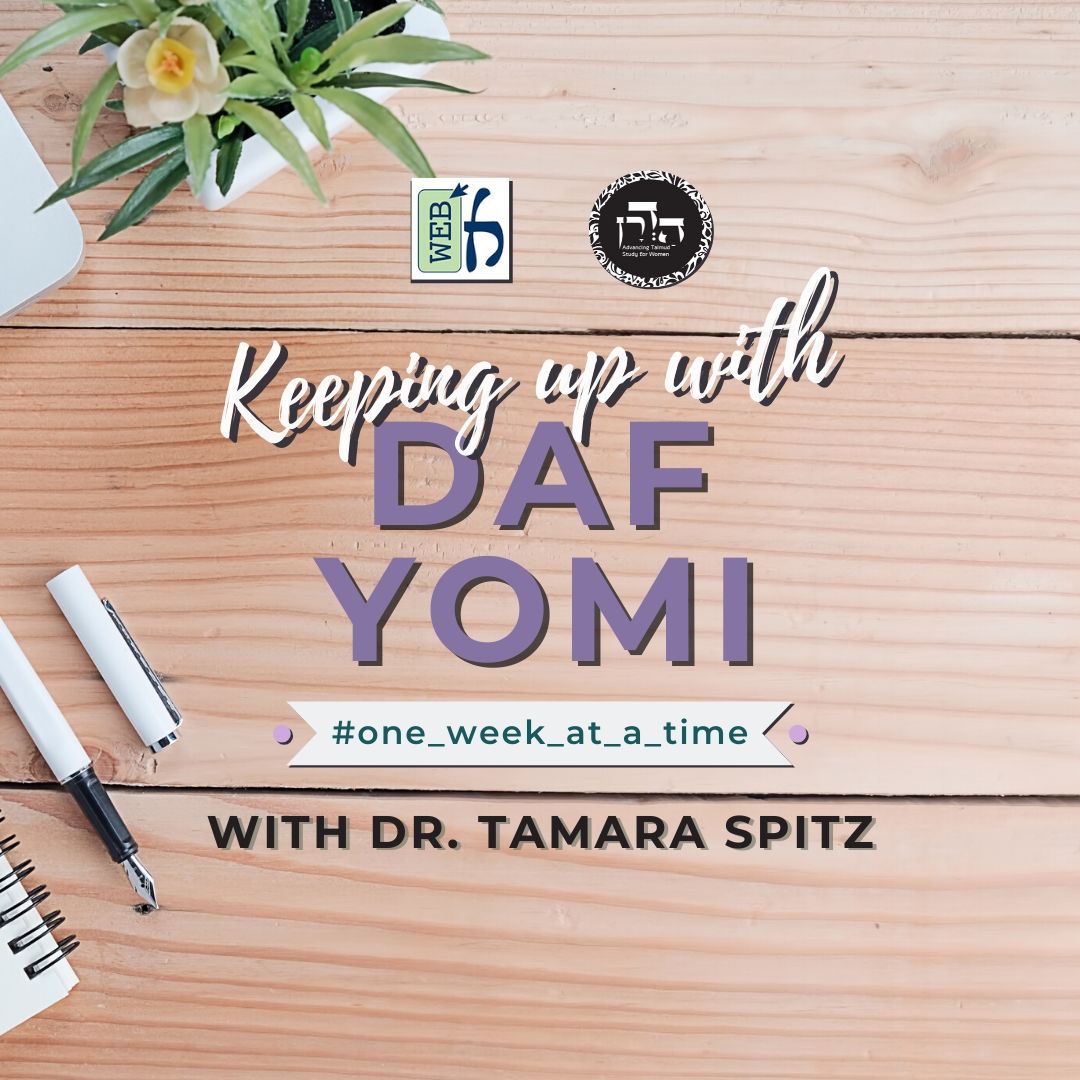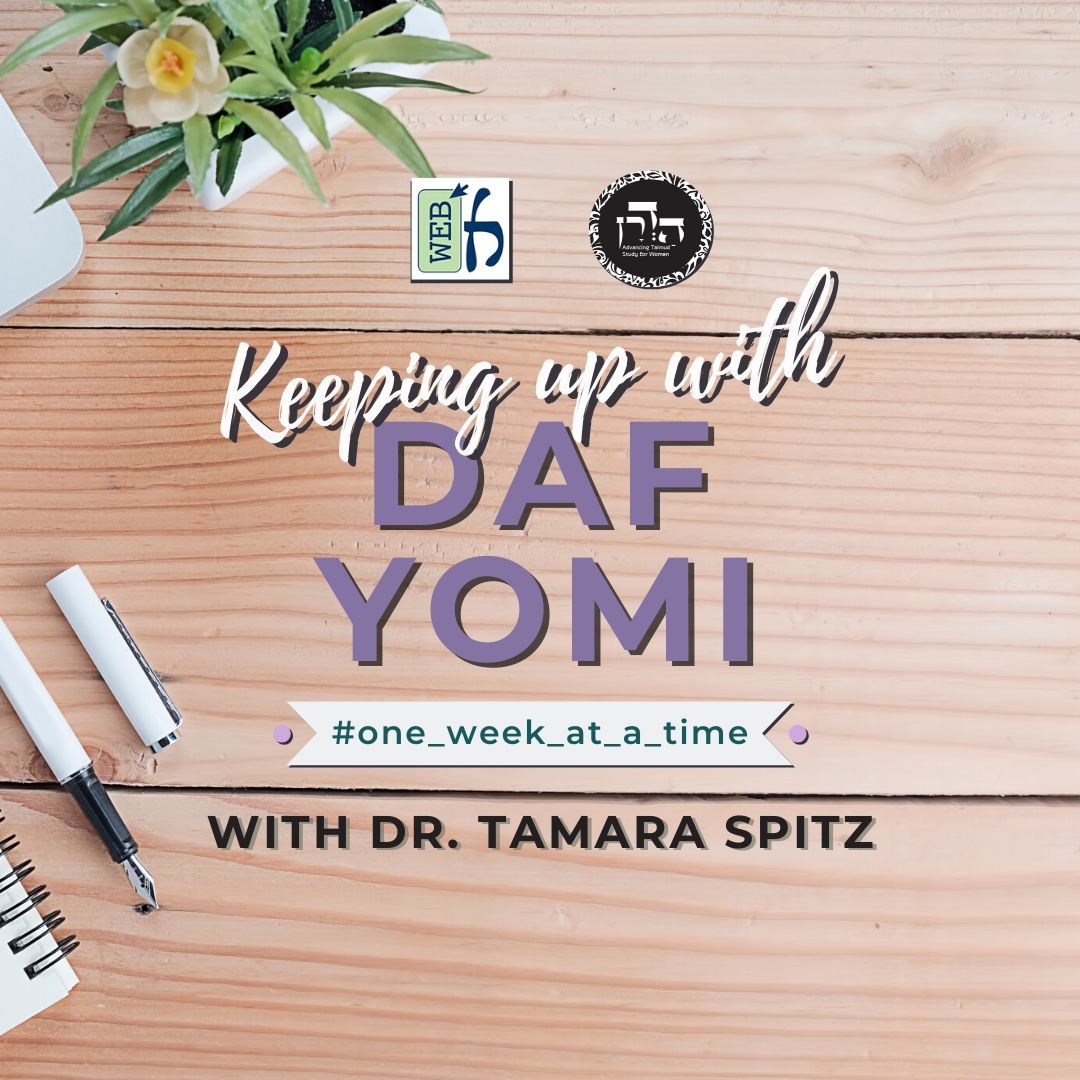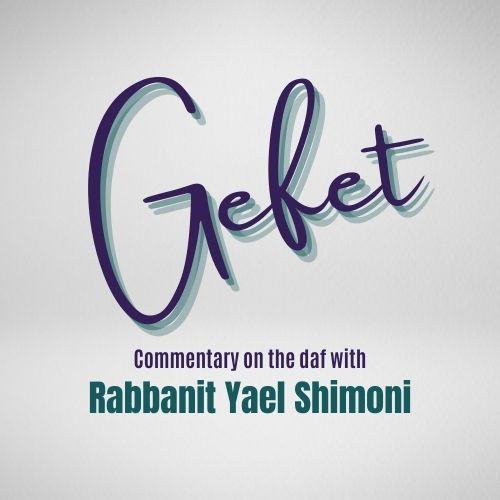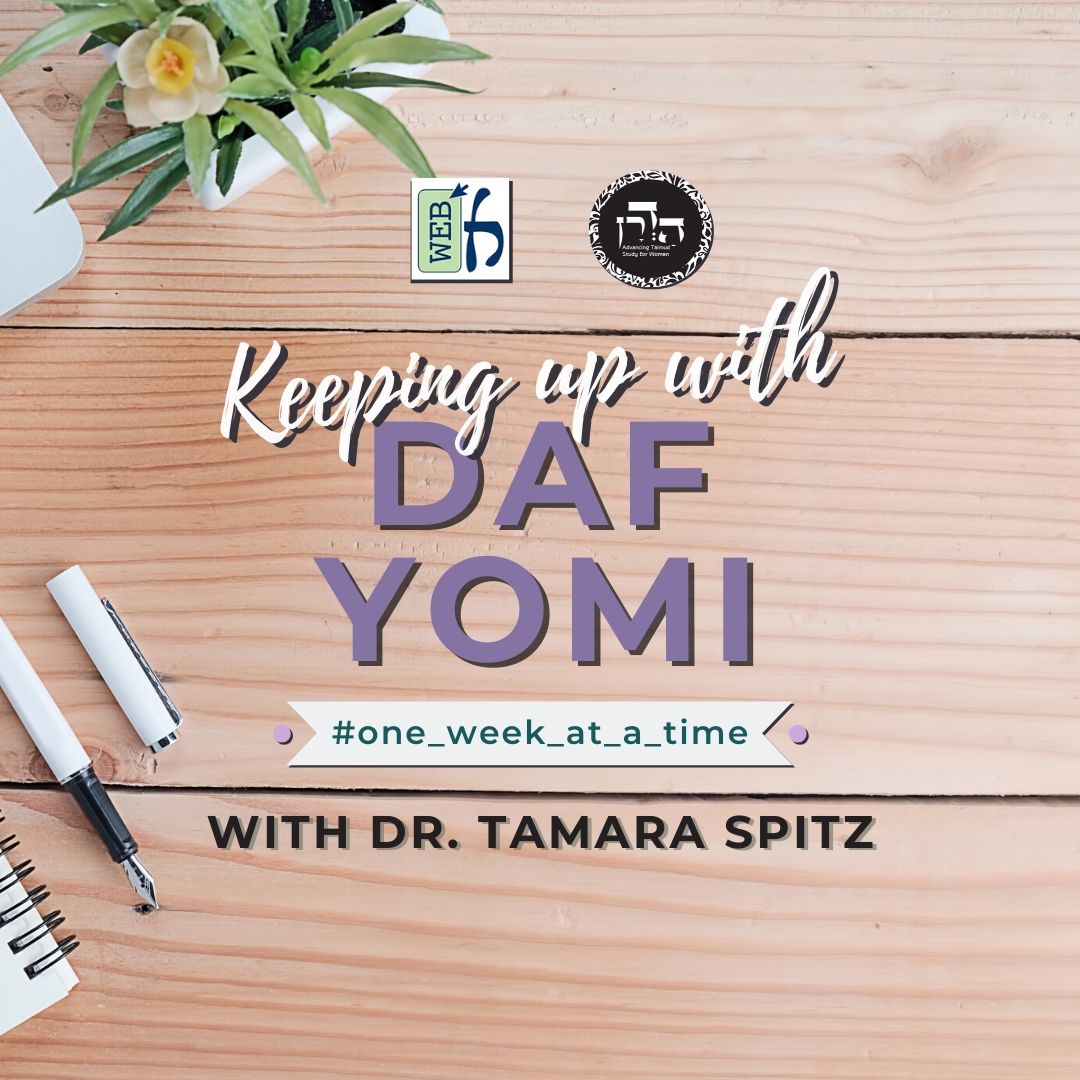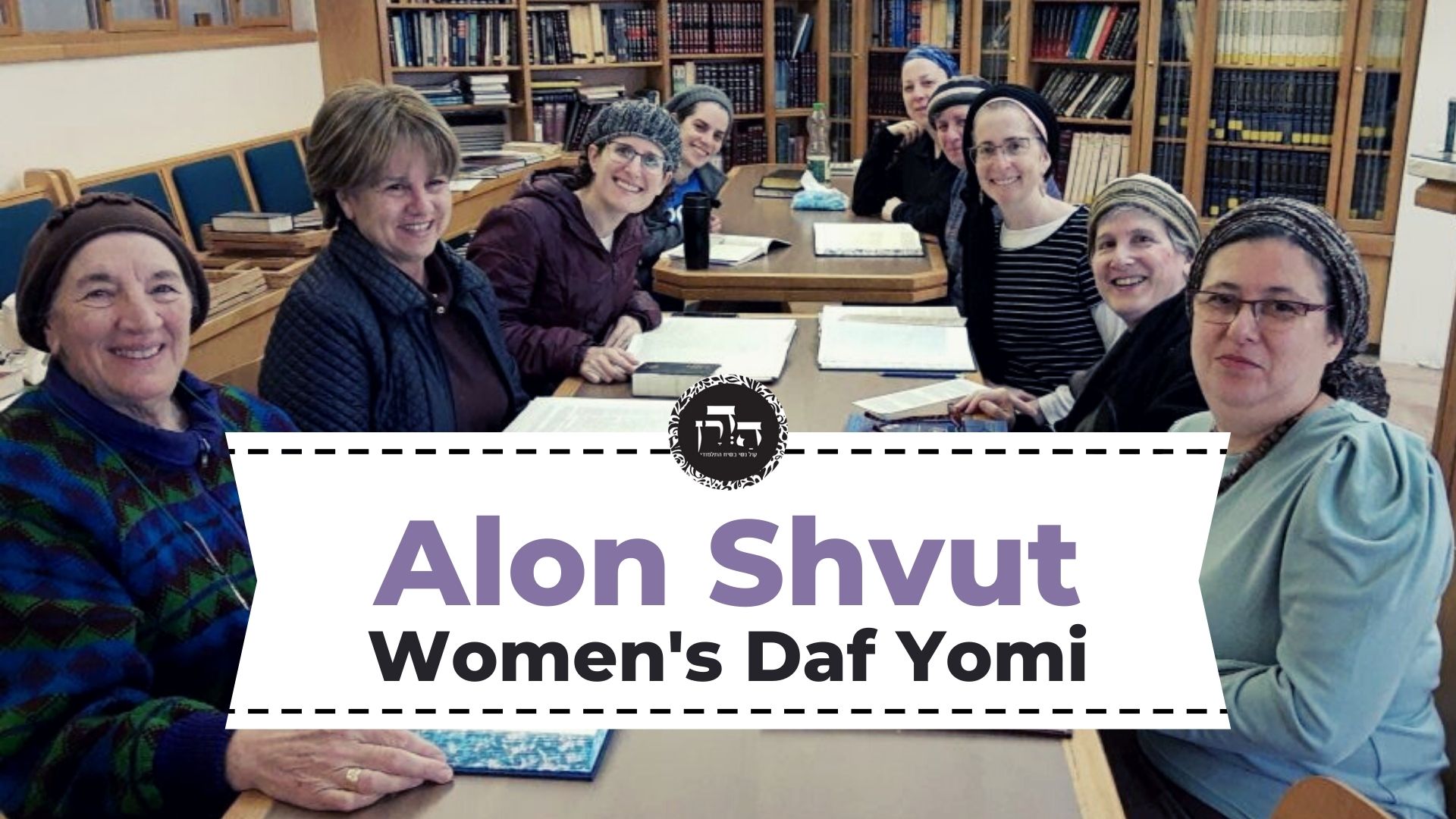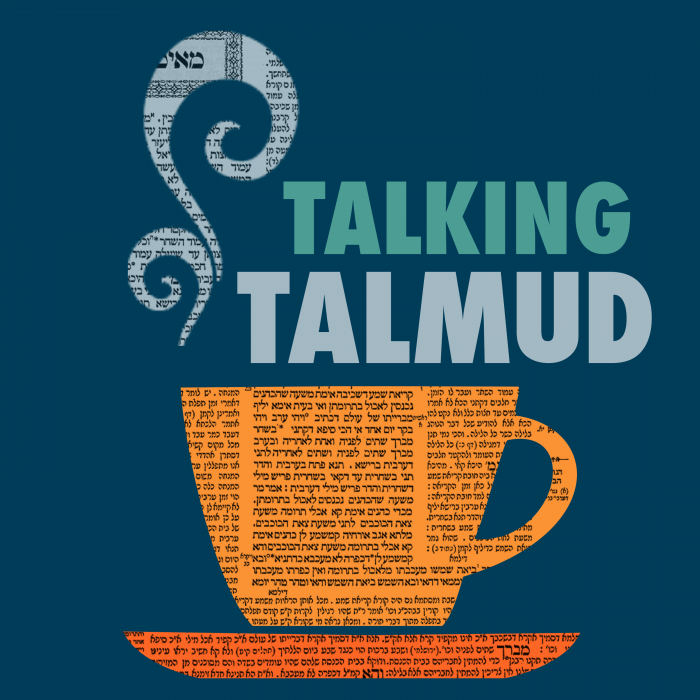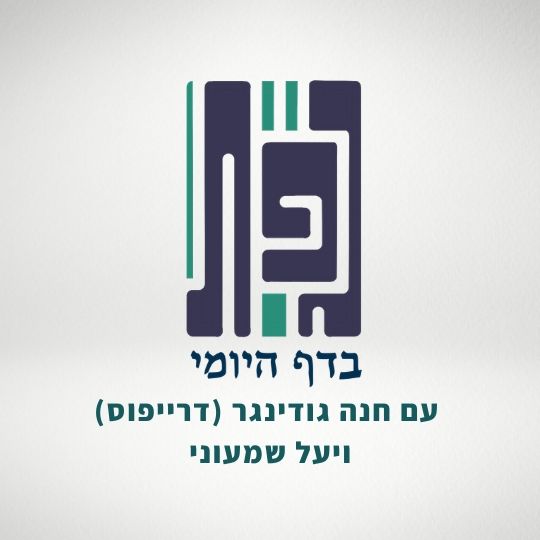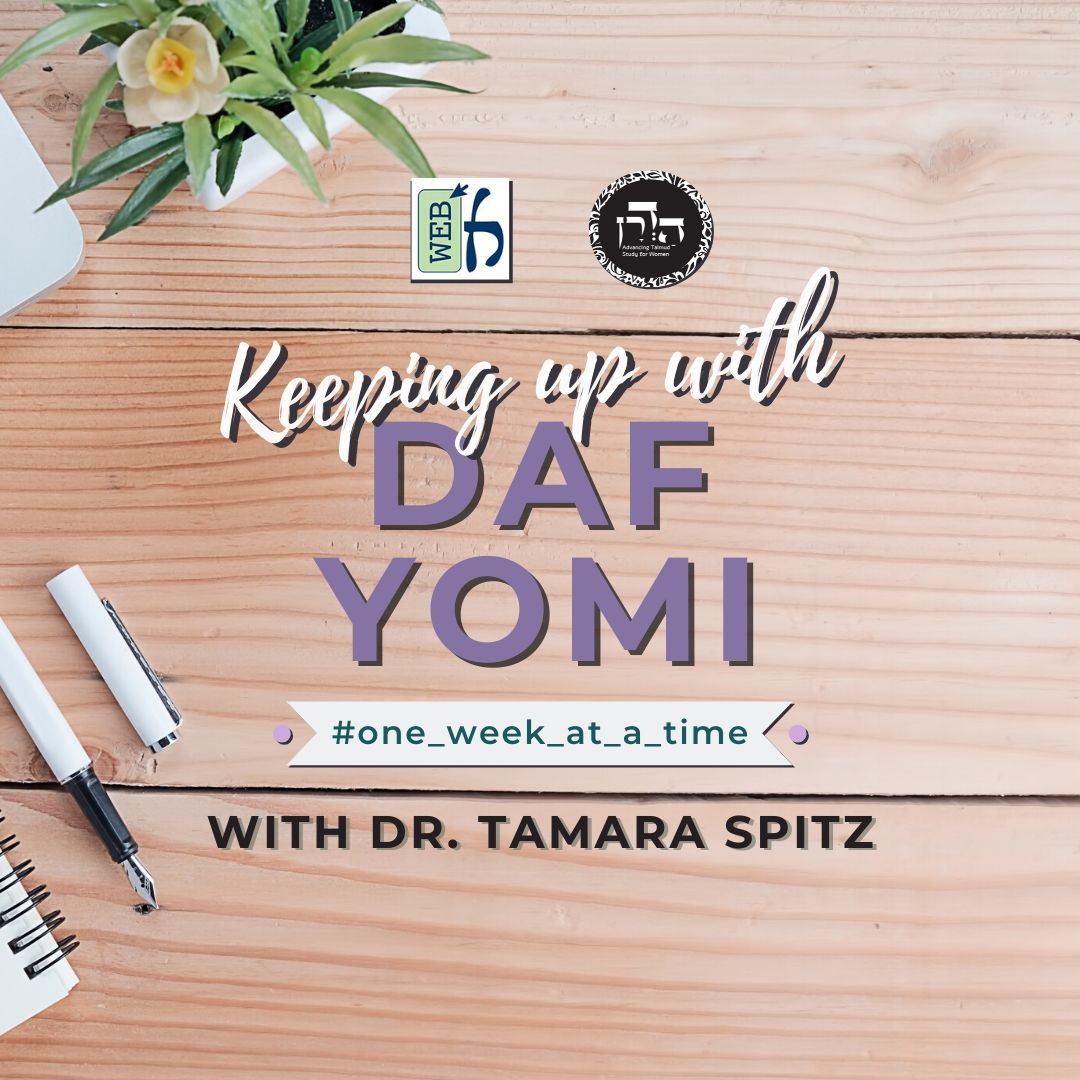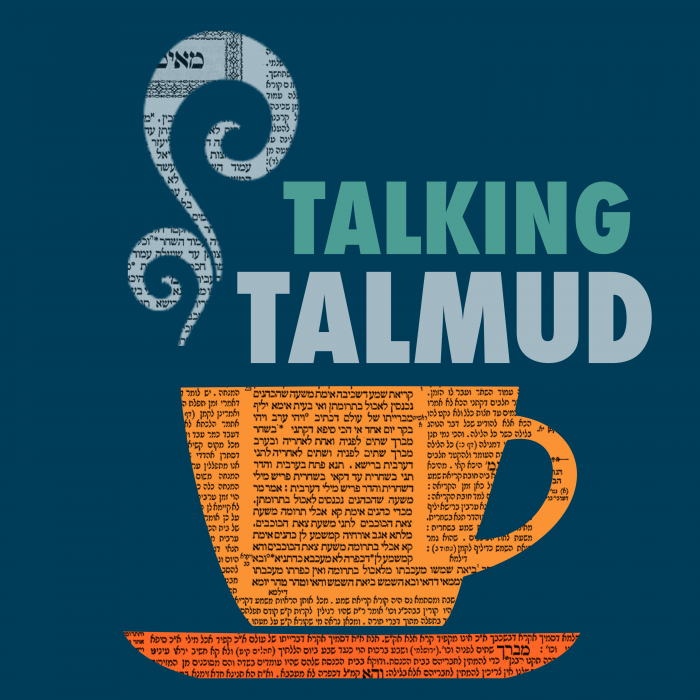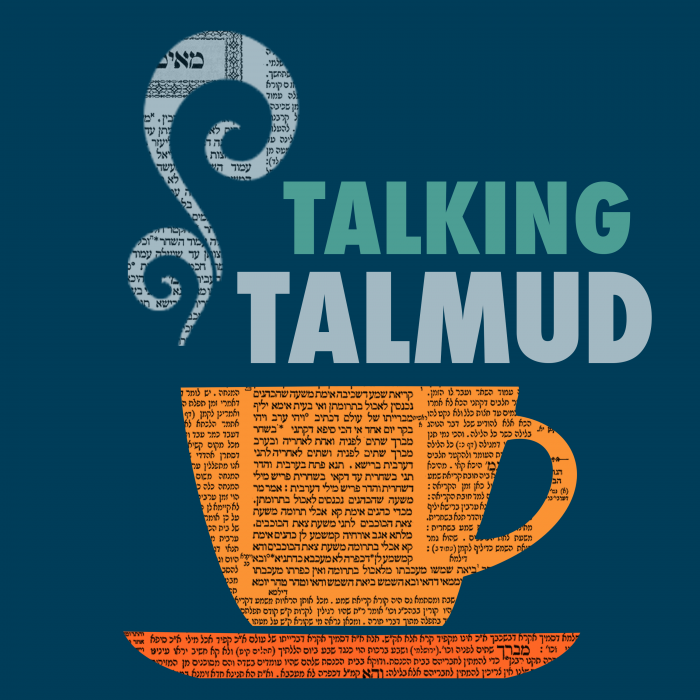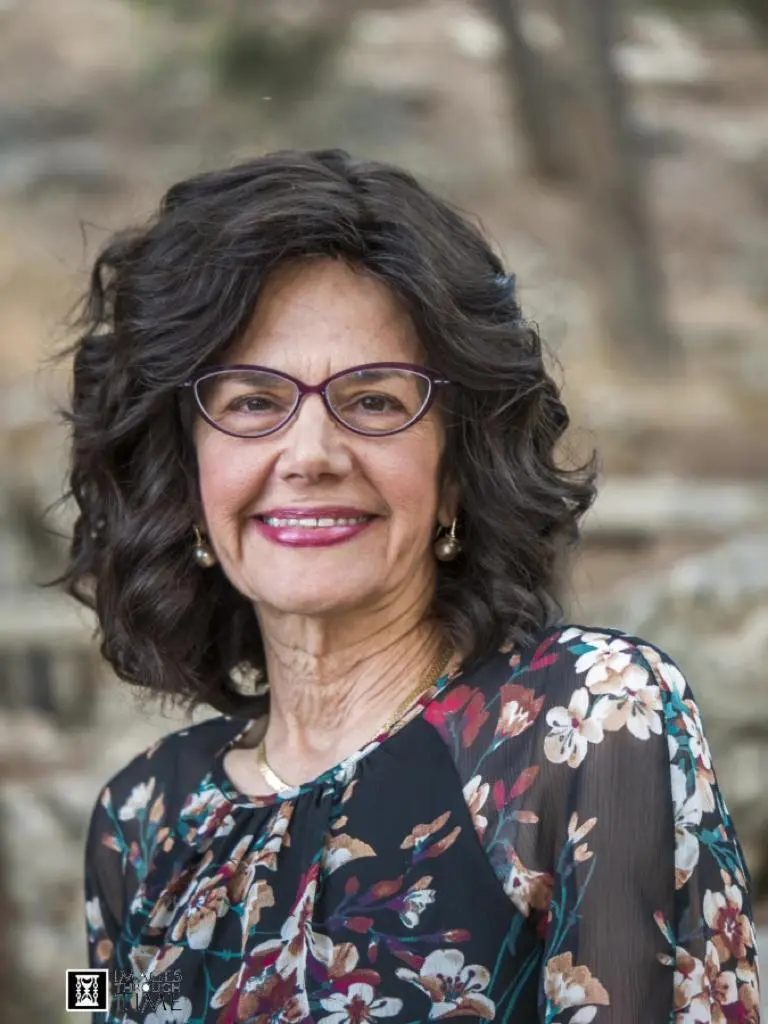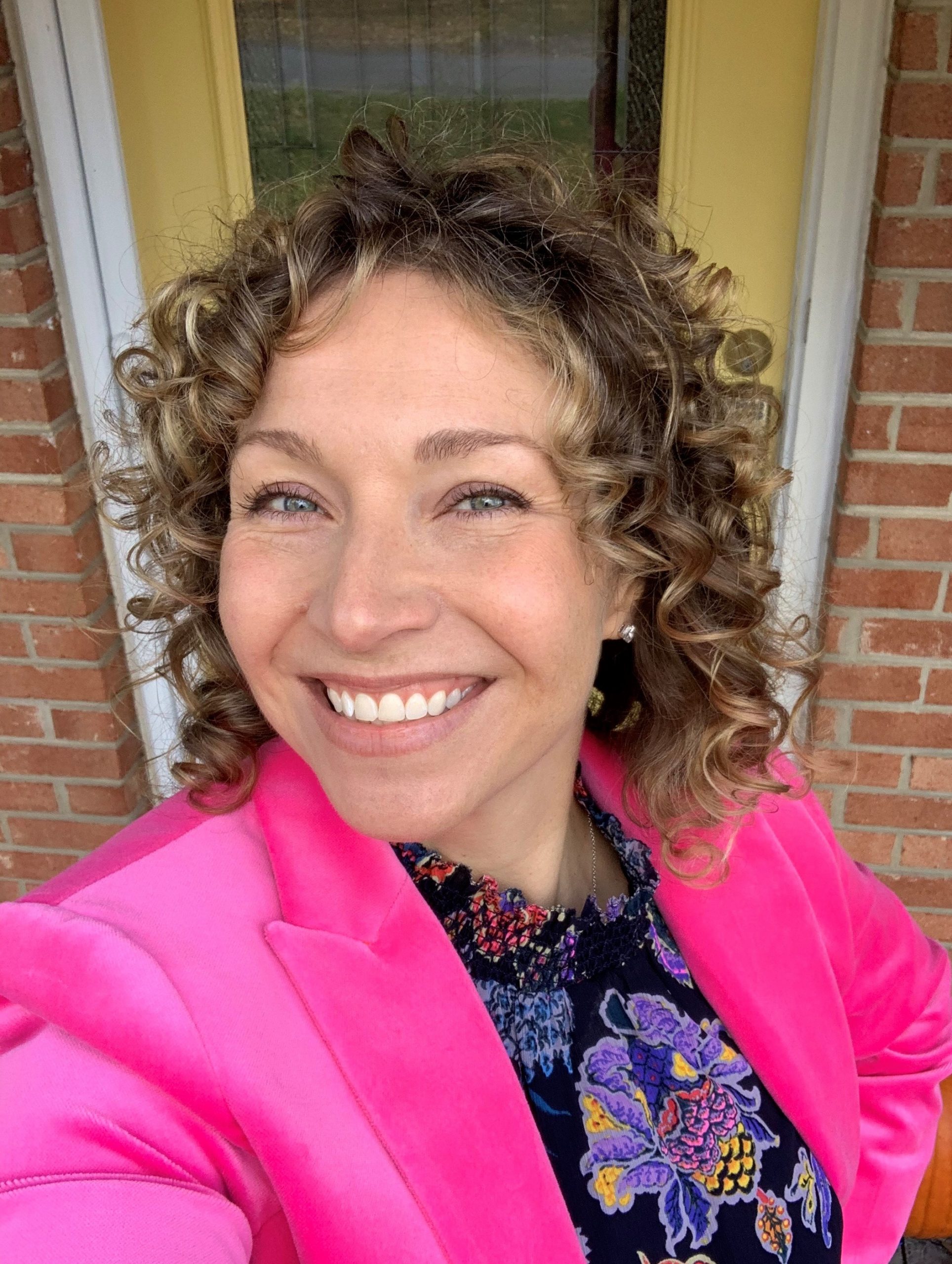Rosh Hashanah 31
שָׁאנֵי הָתָם, דְּשִׁירָה דְּיוֹמֵיהּ הִיא.
The Gemara rejects this argument. It is different there, as in any case “Sing aloud” is the psalm of the day, either because it was an ordinary Thursday or because it was Rosh HaShana. However, there is no proof from here that in all uncertain cases they would recite the psalm for an ordinary weekday, as it is possible that they did not recite any psalm at all.
תַּנְיָא, רַבִּי יְהוּדָה אוֹמֵר מִשּׁוּם רַבִּי עֲקִיבָא: בָּרִאשׁוֹן מָה הָיוּ אוֹמְרִים — ״לַה׳ הָאָרֶץ וּמְלוֹאָהּ״, עַל שֵׁם שֶׁקָּנָה וְהִקְנָה וְשַׁלִּיט בְּעוֹלָמוֹ.
§ The Gemara expands on the topic of the daily psalms recited by the Levites. It is taught in a baraita that Rabbi Yehuda said in the name of Rabbi Akiva: On the first day of the week, Sunday, what psalm would the Levites recite? The psalm beginning with the phrase: “The earth is the Lord’s, and its fullness” (Psalms 24:1), in commemoration of the first day of Creation, because on that day He acquired the world and transferred it to man, and He was the only ruler in His world, as the angels were not created until the second day.
בַּשֵּׁנִי מָה הָיוּ אוֹמְרִים — ״גָּדוֹל ה׳ וּמְהוּלָּל מְאֹד״, עַל שֵׁם שֶׁחִילֵּק מַעֲשָׂיו וּמָלַךְ עֲלֵיהֶן.
On the second day of the week what psalm would the Levites recite? The psalm that begins: “Great is the Lord, and highly to be praised in the city of our God, His sacred mountain” (Psalms 48:2). This is because on the second day of Creation He separated His works, dividing between the upper waters and the lower waters, and ruled over them as King; and this psalm speaks of Jerusalem as “The city of a great King” (Psalms 48:3).
בַּשְּׁלִישִׁי הָיוּ אוֹמְרִים: ״אֱלֹהִים נִצָּב בַּעֲדַת אֵל״, עַל שֵׁם שֶׁגִּילָּה אֶרֶץ בְּחׇכְמָתוֹ, וְהֵכִין תֵּבֵל לַעֲדָתוֹ. בָּרְבִיעִי הָיוּ אוֹמְרִים: ״אֵל נְקָמוֹת ה׳״, עַל שֵׁם שֶׁבָּרָא חַמָּה וּלְבָנָה, וְעָתִיד לִיפָּרַע מֵעוֹבְדֵיהֶן.
On the third day of the week they would recite the psalm beginning: “God stands in the congregation of God” (Psalms 82:1), because on the third day of Creation He revealed the land in His wisdom and thereby prepared the world for His assembly that could now live on the dry land. On the fourth day of the week they would recite the psalm beginning: “O Lord God, to Whom vengeance belongs” (Psalms 94:1), because on the fourth day of Creation He created the sun and the moon, and in the future He will punish and take vengeance upon those who worship them.
בַּחֲמִישִׁי הָיוּ אוֹמְרִים: ״הַרְנִינוּ לֵאלֹהִים עוּזֵּנוּ״, עַל שֵׁם שֶׁבָּרָא עוֹפוֹת וְדָגִים לְשַׁבֵּחַ לִשְׁמוֹ. בַּשִּׁשִּׁי הָיוּ אוֹמְרִים: ״ה׳ מָלָךְ גֵּאוּת לָבֵשׁ״, עַל שֵׁם שֶׁגָּמַר מְלַאכְתּוֹ וּמָלַךְ עֲלֵיהֶן. בַּשְּׁבִיעִי הָיוּ אוֹמְרִים: ״מִזְמוֹר שִׁיר לְיוֹם הַשַּׁבָּת״, לְיוֹם שֶׁכּוּלּוֹ שַׁבָּת.
On the fifth day of the week the Levites would recite the psalm beginning: “Sing aloud to God our strength” (Psalms 81:2), because on the fifth day of Creation He created birds and fish to praise His name. On the sixth day of the week they would recite the psalm beginning: “The Lord reigns, He is clothed with majesty” (Psalms 93:1), because on that day He completed His labor and ruled over all of creation in full glory. On the seventh day of the week, Shabbat, they would recite the psalm beginning: “A psalm, a song for the day of Shabbat” (Psalms 92:1), as the future world will be a day that is all Shabbat.
אָמַר רַבִּי נְחֶמְיָה: מָה רָאוּ חֲכָמִים לְחַלֵּק בֵּין הַפְּרָקִים הַלָּלוּ? אֶלָּא: בָּרִאשׁוֹן — שֶׁקָּנָה וְהִקְנָה וְשַׁלִּיט בְּעוֹלָמוֹ. בַּשֵּׁנִי — שֶׁחִילֵּק מַעֲשָׂיו וּמָלַךְ עֲלֵיהֶם. בַּשְּׁלִישִׁי — שֶׁגִּילָּה אֶרֶץ בְּחׇכְמָתוֹ וְהֵכִין תֵּבֵל לַעֲדָתוֹ.
Rabbi Neḥemya said: What did the Sages see that led them to distinguish between these chapters, as they interpret the psalms recited on the six weekdays as referring to the past, whereas the psalm recited on Shabbat is referring to the future. Rather, all of the psalms refer to the past. The first six are as explained above: On the first day, the reason is that He acquired the world and transferred it to man, and He was the only ruler in His world; on the second day, the reason is that He separated His works and ruled over them as King; on the third day, the reason is that He revealed the land in His wisdom and thereby prepared the world for His assembly.
בָּרְבִיעִי — שֶׁבָּרָא חַמָּה וּלְבָנָה וְעָתִיד לִיפָּרַע מֵעוֹבְדֵיהֶן. בַּחֲמִישִׁי — שֶׁבָּרָא עוֹפוֹת וְדָגִים לְשַׁבֵּחַ לִשְׁמוֹ. בַּשִּׁשִּׁי — שֶׁגָּמַר מְלַאכְתּוֹ וּמָלַךְ עֲלֵיהֶם. בַּשְּׁבִיעִי — עַל שֵׁם שֶׁשָּׁבַת.
On the fourth day, the reason is that He created the sun and the moon, and in the future He will punish those who worship them; on the fifth day, the reason is that He created birds and fish to praise His name; on the sixth day, the reason is that He completed His labor and ruled over all of creation. However, on the seventh day, the reason is that He rested from His work, as the phrase “A psalm, a song for the day of Shabbat” is referring to the first Shabbat of Creation.
וְקָמִיפַּלְגִי בִּדְרַב קַטִּינָא, דְּאָמַר רַב קַטִּינָא: שִׁיתָּא אַלְפֵי שְׁנֵי הָוֵה עָלְמָא וְחַד חָרוּב, שֶׁנֶּאֱמַר: ״וְנִשְׂגַּב ה׳ לְבַדּוֹ בְּיוֹם הַהוּא״. אָמַר אַבָּיֵי: תְּרֵי חָרוּב, שֶׁנֶּאֱמַר: ״יְחַיֵּינוּ מִיּוֹמָיִם״.
The Gemara comments: And these tanna’im disagree with regard to a statement of Rav Ketina, as Rav Ketina said: The world will exist for six thousand years, and for one thousand years it will be destroyed, as it is stated: “And the Lord alone shall be exalted on that day” (Isaiah 2:11), and one day for God is a thousand years, as indicated in the verse: “For a thousand years in Your sight are but as yesterday when it is past” (Psalms 90:4). Rav Ketina’s statement is in accordance with the opinion of Rabbi Akiva. Conversely, Abaye said: The world will be destroyed for two thousand years, as it is stated: “After two days He will revive us” (Hosea 6:2). According to the opinion of Abaye that the destruction will be for two days, there is no connection between the future world and the day of Shabbat, which is only one day.
בְּמוּסְפֵי דְשַׁבְּתָא מָה הָיוּ אוֹמְרִים? אָמַר רַב עָנָן בַּר רָבָא אָמַר רַב: ״הַזִּיו לָךְ״.
§ The Gemara further asks: When it came to the additional offerings of Shabbat, what would the Levites recite? Rav Anan bar Rava said that Rav said: They would recite in accordance with the mnemonic hei, zayin, yod, vav, lamed, kaf. They would divide the song of Ha’azinu into six sections, each of which began with a letter of the mnemonic: “Give ear [ha’azinu], you heavens” (Deuteronomy 32:1); “Remember [zekhor] the days of old” (Deuteronomy 32:7); “He made him ride [yarkivehu] on the high places of the earth” (Deuteronomy 32:13); “The Lord saw it [vayar] and spurned” (Deuteronomy 32:19); “Were it not [lulei] that I dread the enemy’s provocation” (Deuteronomy 32:27); “For [ki] the Lord will judge His people” (Deuteronomy 32:36).
וְאָמַר רַב חָנָן בַּר רָבָא אָמַר רַב: כְּדֶרֶךְ שֶׁחֲלוּקִים כָּאן — כָּךְ חֲלוּקִין בְּבֵית הַכְּנֶסֶת.
And Rav Ḥanan bar Rava said that Rav said: In the manner that the verses of the song of Ha’azinu are divided here for the recitation of the additional offerings of Shabbat in the Temple, so too are they divided when they are read in the synagogue on Shabbat.
בְּמִנְחֲתָא דְשַׁבְּתָא מָה הָיוּ אוֹמְרִים? אָמַר רַבִּי יוֹחָנָן: ״אָז יָשִׁיר״, וּ״מִי כָמוֹךָ״, וְ״אָז יָשִׁיר״.
The Gemara asks another question: When it came to the daily afternoon offering on Shabbat, what would the Levites recite? Rabbi Yoḥanan said: “Then sang Moses” (Exodus 15:1), and: “Who is like You” (Exodus 15:11), the two halves of the Song of the Sea, and: “Then Israel sang this song” (Numbers 21:17), the entire Song of the Well.
אִיבַּעְיָא לְהוּ: הָנֵי כּוּלְּהוּ בְּחַד שַׁבְּתָא אָמְרִי לְהוּ, אוֹ דִלְמָא כֹּל שַׁבְּתָא וְשַׁבְּתָא אָמְרִי חַד? תָּא שְׁמַע, דְּתַנְיָא, אָמַר רַבִּי יוֹסֵי: עַד שֶׁהָרִאשׁוֹנָה אוֹמֶרֶת אַחַת — שְׁנִיָּה חוֹזֶרֶת שְׁתַּיִם. שְׁמַע מִינַּהּ כׇּל שַׁבְּתָא וְשַׁבְּתָא אָמְרִי חַד, שְׁמַע מִינַּהּ.
A dilemma was raised before the Sages: Does one recite all these sections of the song of Ha’azinu on each Shabbat, or perhaps on each and every Shabbat they would recite one section? The Gemara suggests: Come and hear, as it is taught in a baraita that Rabbi Yosei said: By the time that those who recite the first set, i.e., the verses for the additional offerings brought on Shabbat, recite it once, those who recite the second set, for the daily afternoon offering, would repeat their cycle twice, as the first set was comprised of six sections, whereas the second set included only three sections. Learn from here that each and every Shabbat they would recite only one section. The Gemara concludes: Indeed, learn from here that this is correct.
אָמַר רַב יְהוּדָה בַּר אִידֵּי אָמַר רַבִּי יוֹחָנָן: עֶשֶׂר מַסָּעוֹת נָסְעָה שְׁכִינָה, מִקְּרָאֵי, וּכְנֶגְדָּן גָּלְתָה סַנְהֶדְרִין, מִגְּמָרָא.
§ Rav Yehuda bar Idi said that Rabbi Yoḥanan said: The Divine Presence traveled ten journeys, i.e., it left the Temple and Eretz Yisrael in ten stages at the time of the destruction of the First Temple, as derived from verses. And corresponding to them the Sanhedrin was exiled in ten stages at the end of the Second Temple period and after the destruction of the Temple, and this is known from tradition.
עֶשֶׂר מַסָּעוֹת נָסְעָה שְׁכִינָה, מִקְּרָאֵי: מִכַּפֹּרֶת לִכְרוּב, וּמִכְּרוּב לִכְרוּב, וּמִכְּרוּב לְמִפְתָּן, וּמִמִּפְתָּן לְחָצֵר, וּמֵחָצֵר לְמִזְבֵּחַ, וּמִמִּזְבֵּחַ לְגַג, וּמִגַּג לְחוֹמָה, וּמֵחוֹמָה לָעִיר, וּמֵעִיר לְהַר, וּמֵהַר לְמִדְבָּר, וּמִמִּדְבָּר עָלְתָה וְיָשְׁבָה בִּמְקוֹמָהּ — שֶׁנֶּאֱמַר: ״אֵלֵךְ אָשׁוּבָה אֶל מְקוֹמִי״.
The Gemara elaborates. The Divine Presence traveled ten journeys, as derived from verses. The ten journeys are: From the Ark cover to the cherub; and from one cherub to the other cherub; and from the second cherub to the threshold of the Sanctuary; and from the threshold to the courtyard; and from the courtyard to the altar; and from the altar to the roof; and from the roof to the wall of the Temple Mount; and from the wall to the city; and from the city to a mountain close to Jerusalem; and from that mountain to the wilderness; and from the wilderness it ascended and rested in its place in Heaven, isolated from humanity, as it is stated: “I will go and return to My place” (Hosea 5:15).
מִכַּפּוֹרֶת לִכְרוּב, מִכְּרוּב לִכְרוּב, וּמִכְּרוּב לְמִפְתָּן — דִּכְתִיב: ״וְנוֹעַדְתִּי לְךָ שָׁם וְדִבַּרְתִּי אִתְּךָ מֵעַל הַכַּפּוֹרֶת״, וּכְתִיב: ״וַיִּרְכַּב עַל כְּרוּב וַיָּעֹף״, וּכְתִיב: ״וּכְבוֹד אֱלֹהֵי יִשְׂרָאֵל נַעֲלָה מֵעַל הַכְּרוּב אֲשֶׁר הָיָה עָלָיו אֶל מִפְתַּן הַבָּיִת״.
The Gemara cites the sources for each of these stages: From the Ark cover the Divine Presence traveled to the cherub, and from one cherub to the other cherub, and from the second cherub to the threshold, as it is written with regard to Moses in the Tabernacle: “And there I will meet with you, and I will speak to you from above the Ark cover, from between the two cherubs” (Exodus 25:22). And it is written: “And He rode upon a cherub, and flew” (II Samuel 22:11), which indicates that the glory of the Divine Presence can rest upon one cherub. And it is written: “And the glory of the God of Israel had ascended from the cherub, on which it was, to the threshold of the House” (Ezekiel 9:3), i.e., the Divine Presence moved from the cherub to the threshold.
וּמִמִּפְתָּן לְחָצֵר, דִּכְתִיב: ״וַיִּמָּלֵא הַבַּיִת אֶת הֶעָנָן וְהֶחָצֵר מָלְאָה אֶת נֹגַהּ כְּבוֹד ה׳״. מֵחָצֵר לְמִזְבֵּחַ, דִּכְתִיב: ״רָאִיתִי אֶת ה׳ נִצָּב עַל הַמִּזְבֵּחַ״. וּמִמִּזְבֵּחַ לְגַג, דִּכְתִיב: ״טוֹב לָשֶׁבֶת עַל פִּנַּת גָּג״. מִגַּג לְחוֹמָה, דִּכְתִיב: ״וְהִנֵּה ה׳ נִצָּב עַל חוֹמַת אֲנָךְ״. מֵחוֹמָה לָעִיר, דִּכְתִיב: ״קוֹל ה׳ לָעִיר יִקְרָא״.
And from the threshold of the Sanctuary the Divine Presence went to the courtyard, as it is written: “And the House was filled with the cloud and the courtyard was full of the brightness of the Lord’s glory” (Ezekiel 10:4). From the courtyard to the altar, as it is written: “I saw the Lord standing on the altar” (Amos 9:1). And from the altar to the roof, as it is written: “It is better to dwell in a corner of the roof than in a house together with a contentious woman” (Proverbs 21:9). From the roof to the wall, as it is written: “And behold, the Lord stood upon a wall made by a plumb line” (Amos 7:7). From the wall to the city, as it is written: “The Lord’s voice cries to the city” (Micah 6:9).
וּמֵעִיר לְהַר, דִּכְתִיב: ״וַיַּעַל כְּבוֹד ה׳ מֵעַל תּוֹךְ הָעִיר וַיַּעֲמֹד עַל הָהָר אֲשֶׁר מִקֶּדֶם לָעִיר״. וּמֵהַר לְמִדְבָּר, דִּכְתִיב: ״טוֹב שֶׁבֶת בְּאֶרֶץ מִדְבָּר״. וּמִמִּדְבָּר עָלְתָה וְיָשְׁבָה בִּמְקוֹמָהּ, דִּכְתִיב: ״אֵלֵךְ אָשׁוּבָה אֶל מְקוֹמִי וְגוֹ׳״.
And from the city the Divine Presence arose to the mountain nearest the Sanctuary, i.e., the Mount of Olives, as it is written: “And the glory of the Lord went up from the midst of the city, and stood upon the mountain, which is on the east side of the city” (Ezekiel 11:23). And from the mountain to the wilderness, as it is written: “It is better to live in the wilderness than with a contentious and fretful woman” (Proverbs 21:19). And from the wilderness it ascended and rested in its place in Heaven, as it is written: “I will go and return to My place until they acknowledge their guilt” (Hosea 5:15).
אָמַר רַבִּי יוֹחָנָן: שִׁשָּׁה חֳדָשִׁים נִתְעַכְּבָה שְׁכִינָה לְיִשְׂרָאֵל בַּמִּדְבָּר, שֶׁמָּא יַחְזְרוּ בִּתְשׁוּבָה. כֵּיוָן שֶׁלֹּא חָזְרוּ — אָמַר: תִּיפַּח עַצְמָן, שֶׁנֶּאֱמַר: ״וְעֵינֵי רְשָׁעִים תִּכְלֶינָה וּמָנוֹס אָבַד מִנְהֶם וְתִקְוָתָם מַפַּח נָפֶשׁ״.
Rabbi Yoḥanan said: For six months the Divine Presence lingered in the wilderness, waiting for the Jewish people, hoping that perhaps they would repent and it would be able to return to its place. When they did not repent, the Divine Presence said: Let them despair and be lost, as it is stated: “But the eyes of the wicked shall fail, and they shall have no way to flee, and their hope shall be the drooping of the soul” (Job 11:20). This concludes the discussion of the ten stages of the exile of the Divine Presence from the Holy of Holies.
וּכְנֶגְדָּן גָּלְתָה סַנְהֶדְרִין, מִגְּמָרָא: מִלִּשְׁכַּת הַגָּזִית לַחֲנוּת, וּמֵחֲנוּת לִירוּשָׁלַיִם, וּמִירוּשָׁלַיִם לְיַבְנֶה,
And corresponding to these ten stages, the Sanhedrin was exiled in ten stages at the end of the Second Temple period and after the destruction of the Temple, and this is known from tradition: From the Chamber of Hewn Stone, its fixed seat in the Temple, to Ḥanut, literally, shop, a designated spot on the Temple Mount outside the Temple proper; and from Ḥanut to Jerusalem; and from Jerusalem to Yavne;
וּמִיַּבְנֶה לְאוּשָׁא, וּמֵאוּשָׁא לְיַבְנֶה, וּמִיַּבְנֶה לְאוּשָׁא, וּמֵאוּשָׁא לִשְׁפַרְעָם, וּמִשְּׁפַרְעָם לְבֵית שְׁעָרִים, וּמִבֵּית שְׁעָרִים לְצִפּוֹרִי, וּמִצִּפּוֹרִי לִטְבֶרְיָא. וּטְבֶרְיָא עֲמוּקָּה מִכּוּלָּן, שֶׁנֶּאֱמַר: ״וְשָׁפַלְתְּ מֵאֶרֶץ תְּדַבֵּרִי״.
and from Yavne to Usha; and from Usha it returned to Yavne; and from Yavne it went back to Usha; and from Usha to Shefaram; and from Shefaram to Beit She’arim; and from Beit She’arim to Tzippori; and from Tzippori to Tiberias. And Tiberias is lower than all of them, as it is in the Jordan Valley. A verse alludes to these movements, as it is stated: “And brought down, you shall speak out of the ground” (Isaiah 29:4).
רַבִּי אֶלְעָזָר אוֹמֵר: שֵׁשׁ גָּלוּת, שֶׁנֶּאֱמַר: ״כִּי הֵשַׁח יוֹשְׁבֵי מָרוֹם קִרְיָה נִשְׂגָּבָה יַשְׁפִּילֶנָּה יַשְׁפִּילָהּ עַד אֶרֶץ יַגִּיעֶנָּה עַד עָפָר״. אָמַר רַבִּי יוֹחָנָן: וּמִשָּׁם עֲתִידִין לִיגָּאֵל, שֶׁנֶּאֱמַר: ״הִתְנַעֲרִי מֵעָפָר קוּמִי שְּׁבִי״.
Rabbi Elazar says: There are six exiles, if you count only the places, not the number of journeys, and a different verse alludes to this, as it is stated: “For He has brought down those who dwell high, the lofty city laying it low, laying it low, to the ground, bringing it to the dust” (Isaiah 26:5). This verse mentions six expressions of lowering: Brought down, laying it low, laying it low, to the ground, bringing it, and to the dust. Rabbi Yoḥanan said: And from there, i.e., from their lowest place of descent, they are destined to be redeemed in the future, as it is stated: “Shake yourself from the dust, arise, sit, Jerusalem” (Isaiah 52:2).
מַתְנִי׳ אָמַר רַבִּי יְהוֹשֻׁעַ בֶּן קׇרְחָה: וְעוֹד זֹאת הִתְקִין רַבָּן יוֹחָנָן בֶּן זַכַּאי, שֶׁאֲפִילּוּ רֹאשׁ בֵּית דִּין בְּכׇל מָקוֹם, שֶׁלֹּא יְהוּ הָעֵדִים הוֹלְכִין אֶלָּא לִמְקוֹם הַוַּעַד.
MISHNA: Rabbi Yehoshua ben Korḥa said: And this, too, Rabban Yoḥanan ben Zakkai instituted, that even if the head of the court of seventy-one is in any other place, not where the Great Sanhedrin is in session, the witnesses should nevertheless go only to the place where the Great Sanhedrin gathers to deliver testimony to determine the start of the month. Although the date of the month is dependent on the head of the Great Sanhedrin, as it is he who declares that the month is sanctified (see 24a), nevertheless, Rabban Yoḥanan ben Zakkai instituted that the members of the Great Sanhedrin may sanctify the month in the absence of the head of the court.
גְּמָ׳ הַהִיא אִיתְּתָא דְּאַזְמְנוּהָ לְדִינָא קַמֵּיהּ דְּאַמֵּימָר בִּנְהַרְדְּעָא. אֲזַל אַמֵּימָר לְמָחוֹזָא, וְלָא אֲזַלָה בָּתְרֵיהּ. כְּתַב פְּתִיחָא עִילָּוַהּ. אֲמַר לֵיהּ רַב אָשֵׁי לְאַמֵּימָר, וְהָא אֲנַן תְּנַן: אֲפִילּוּ רֹאשׁ בֵּית דִּין בְּכׇל מָקוֹם, שֶׁלֹּא יְהוּ הָעֵדִים הוֹלְכִין אֶלָּא לִמְקוֹם הַוַּעַד!
GEMARA: The Gemara relates: There was a certain woman who was called to judgment before Ameimar in Neharde’a. Ameimar temporarily went to Meḥoza, and she did not follow him to be judged there. He wrote a document of excommunication [petiḥa] concerning her, for disobeying the court. Rav Ashi said to Ameimar: Didn’t we learn in the mishna: Even if the head of the court of seventy-one is in any other place, the witnesses should go only to the place where the Great Sanhedrin gathers? This shows that one must appear in the court itself, rather than follow the head of the court.
אֲמַר לֵיהּ: הָנֵי מִילֵּי לְעִנְיַן עֵדוּת הַחֹדֶשׁ, דְּאִם כֵּן נִמְצֵאתָ מַכְשִׁילָן לֶעָתִיד לָבֹא. אֲבָל הָכָא — ״עֶבֶד לֹוֶה לְאִישׁ מַלְוֶה״.
Ameimar said to him: This applies only to testimony to determine the start of the month, for which it is necessary to have a fixed place. The reason is that if so, if the witnesses come to court when the head of the court is absent and they will have to go to another place, consequently you will be obstructing them for future occasions, as they will consider it too much trouble and perhaps they will not come the next time. Therefore, the Sages said that these witnesses should go to the regular place where the Great Sanhedrin meets. However, here, with regard to monetary claims, the verse states: “The borrower is servant to the lender” (Proverbs 22:7), i.e., the defendant must act as is convenient to the claimant and the court.
תָּנוּ רַבָּנַן: אֵין כֹּהֲנִים רַשָּׁאִין לַעֲלוֹת בְּסַנְדְּלֵיהֶן לַדּוּכָן, וְזוֹ אֶחָד מִתֵּשַׁע תַּקָּנוֹת שֶׁהִתְקִין רַבָּן יוֹחָנָן בֶּן זַכַּאי. שֵׁית דְּהַאי פִּירְקָא, וַחֲדָא דְּפִירְקָא קַמָּא.
§ The Sages taught in a baraita: Priests are not allowed to ascend with their sandals to the platform to recite the Priestly Blessing in the synagogue. And this is one of the nine ordinances that Rabban Yoḥanan ben Zakkai instituted. Six are mentioned in this chapter: Sounding the shofar on Shabbat in Yavne, taking the lulav all seven days, the prohibition against eating new grain the entire day of waving, accepting testimony to determine the start of the month all day, having the witnesses to the New Moon go to the place of meeting, and reciting the Priestly Blessing without sandals. And one is stated in the first chapter, that the witnesses to the New Moon may desecrate Shabbat only for the months of Tishrei and Nisan.
וְאִידַּךְ, דְּתַנְיָא: גֵּר שֶׁנִּתְגַּיֵּיר בַּזְּמַן הַזֶּה, צָרִיךְ שֶׁיַּפְרִישׁ רוֹבַע לְקִינּוֹ. אָמַר רַבִּי שִׁמְעוֹן בֶּן אֶלְעָזָר: כְּבָר נִמְנָה עָלֶיהָ רַבָּן יוֹחָנָן וּבִיטְּלָהּ, מִפְּנֵי הַתַּקָּלָה.
And the other, as it is taught in a baraita: A convert who converts nowadays is required to set aside a quarter-shekel for his nest, i.e., his pair of doves. By Torah law a convert must bring two burnt-offerings of birds, in addition to his immersion and circumcision. After the destruction, it was instituted that he must set aside the value of two young pigeons in anticipation of the rebuilding of the Temple. Rabbi Shimon ben Elazar said: Rabban Yoḥanan ben Zakkai already assembled a majority who voted and rescinded the ordinance due to a potential mishap. If a convert is obligated to set aside money, someone might unwittingly use this money, thereby violating the prohibition against misuse of consecrated property.
וְאִידַּךְ פְּלוּגְתָּא דְּרַב פָּפָּא וְרַב נַחְמָן בַּר יִצְחָק. רַב פָּפָּא אָמַר: כֶּרֶם רְבָעִי, רַב נַחְמָן בַּר יִצְחָק אָמַר: לָשׁוֹן שֶׁל זְהוֹרִית.
And the other ordinance, the ninth, is the subject of a dispute between Rav Pappa and Rav Naḥman bar Yitzḥak. Rav Pappa said: The ordinance concerned the fruit of a fourth-year grapevine. Rav Naḥman bar Yitzḥak said: It was with regard to the strip of crimson wool.
רַב פָּפָּא אָמַר: כֶּרֶם רְבָעִי, דְּתַנְיָא: כֶּרֶם רְבָעִי הָיָה עוֹלֶה לִירוּשָׁלַיִם מַהֲלַךְ יוֹם לְכׇל צַד, וְזוֹ הִיא תְּחוּמָהּ: אֵילַת מִן הַצָּפוֹן, וְעַקְרַבַּת מִן הַדָּרוֹם, לוֹד מִן הַמַּעֲרָב, וְיַרְדֵּן מִן הַמִּזְרָח.
The Gemara elaborates: Rav Pappa said that the ordinance is referring to the fruit of a fourth-year grapevine, as it is taught in a mishna (Beitza 5a): The fruit of a fourth-year grapevine has the status of second-tithe fruits, and therefore their owner would ascend to Jerusalem and eat the grapes there. If he is unable to do so, due to the distance involved or the weight of the load, he may redeem the fruits with money where he is, and later redeem that money for other fruits in Jerusalem. However, the Sages decreed that fruit from the environs of Jerusalem should not be redeemed; rather, the owners should bring the fruit itself to Jerusalem. The environs of Jerusalem for this purpose were defined as a day’s walk in each direction. And this is its boundary: Eilat to the north, Akrabat to the south, Lod to the west, and the Jordan river to the east.
וְאָמַר עוּלָּא, וְאִיתֵּימָא רַבָּה בַּר עוּלָּא אָמַר רַבִּי יוֹחָנָן: מָה טַעַם — כְּדֵי לְעַטֵּר שׁוּקֵי יְרוּשָׁלַיִם בְּפֵירוֹת.
And Ulla said, and some say Rabba bar Ulla said that Rabbi Yoḥanan said: For what reason did the Sages institute this ordinance, that one who lives near Jerusalem must bring his fruit there? In order to adorn the markets of Jerusalem with fruit, as this decree ensures that there is always an abundance of fruit in Jerusalem.
וְתַנְיָא: כֶּרֶם רְבָעִי הָיָה לוֹ לְרַבִּי אֱלִיעֶזֶר בְּמִזְרַח לוֹד בְּצַד כְּפַר טָבִי, וּבִיקֵּשׁ רַבִּי אֱלִיעֶזֶר לְהַפְקִירוֹ לַעֲנִיִּים.
And it was further taught in a baraita: Rabbi Eliezer ben Hyrcanus, a student of Rabban Yoḥanan ben Zakkai, had a fourth-year grapevine located between Lod and Jerusalem, to the east of Lod alongside the village of Tavi. The vine was within the boundaries of Jerusalem for the purpose of this halakha. Rabbi Eliezer could not bring the fruit to the Temple, as the Temple had been destroyed, and Rabbi Eliezer sought to render the fruit ownerless in favor of the poor, for whom it would be worth the effort to bring the fruit to Jerusalem.
אָמְרוּ לוֹ תַּלְמִידָיו: רַבִּי, כְּבָר נִמְנוּ חֲבֵרֶיךָ עָלָיו וְהִתִּירוּהוּ. מַאן חֲבֵרֶיךָ — רַבָּן יוֹחָנָן בֶּן זַכַּאי.
His students said to him: Our teacher, there is no need to do so, as your colleagues have already voted on the matter and permitted it, as after the destruction of the Temple there is no need to adorn the markets of Jerusalem. The Gemara explains: Who are: Your colleagues? This is referring to Rabban Yoḥanan ben Zakkai.
רַב נַחְמָן בַּר יִצְחָק אָמַר: לָשׁוֹן שֶׁל זְהוֹרִית, דְּתַנְיָא: בָּרִאשׁוֹנָה הָיוּ קוֹשְׁרִין לָשׁוֹן שֶׁל זְהוֹרִית עַל פֶּתַח אוּלָם מִבַּחוּץ, הִלְבִּין — הָיוּ שְׂמֵחִין, לֹא הִלְבִּין — הָיוּ עֲצֵבִין, הִתְקִינוּ שֶׁיְּהוּ קוֹשְׁרִין אוֹתוֹ עַל פֶּתַח אוּלָם מִבִּפְנִים.
Rav Naḥman bar Yitzḥak said: The ordinance was with regard to the strip of crimson wool used on Yom Kippur. As it is taught in a baraita: At first they would tie a strip of crimson wool to the opening of the Entrance Hall of the Temple on the outside. If, after the sacrificing of the offerings and the sending of the scapegoat, the strip turned white, the people would rejoice, as this indicated that their sins had been atoned for. If it did not turn white they would be sad. When the Sages saw that people were overly distressed on Yom Kippur, they instituted that they should tie the strip of crimson wool to the opening of the Entrance Hall on the inside, where only a few could enter to see it.
וַעֲדַיִין הָיוּ מְצִיצִין וְרוֹאִין, הִלְבִּין — הָיוּ שְׂמֵחִין, לֹא הִלְבִּין — הָיוּ עֲצֵבִין, הִתְקִינוּ שֶׁיְּהוּ קוֹשְׁרִין אוֹתוֹ חֶצְיוֹ בַּסֶּלַע וְחֶצְיוֹ בֵּין קַרְנָיו שֶׁל שָׂעִיר הַמִּשְׁתַּלֵּחַ.
But people would still peek and see it, and once again, if it turned white they would rejoice, and if it did not turn white they would be sad. Therefore, the Sages instituted that they should tie half of the strip to a rock near the place where the one who sent the scapegoat stood and half of it between the horns of the scapegoat, so that the people would not know what happened to the strip until after the conclusion of Yom Kippur. This ordinance was instituted by Rabban Yoḥanan ben Zakkai.
רַב נַחְמָן בַּר יִצְחָק מַאי טַעְמָא לָא אָמַר כְּרַב פָּפָּא? אָמַר לָךְ: אִי סָלְקָא דַעְתָּךְ רַבָּן יוֹחָנָן בֶּן זַכַּאי, חֲבֵרָיו דְּרַבִּי אֱלִיעֶזֶר מִי הֲוָה? רַבּוֹ הֲוָה. וְאִידַּךְ? כֵּיוָן דְּתַלְמִידִים הֲווֹ — לָאו אוֹרַח אַרְעָא לְמֵימְרָא לֵיהּ לְרַבֵּיהּ ״רַבָּךְ״.
The Gemara explains this dispute: What is the reason that Rav Naḥman bar Yitzḥak did not state his opinion with regard to the ordinance in accordance with the opinion of Rav Pappa? He could have said to you: If it enters your mind to say that Rabban Yoḥanan ben Zakkai rescinded the ordinance of the fruit of fourth-year grapevines, was he one of Rabbi Eliezer’s colleagues, that the students would have referred to him in this manner? He was his teacher. Therefore, Rabbi Yoḥanan cannot be the one who instituted this ordinance. And the other, Rav Pappa, what would he respond to this? He would say that since they were Rabbi Eliezer’s students it is not proper conduct for one to say to his teacher: Your teacher. Therefore, they referred to Rabbi Yoḥanan as Rabbi Eliezer’s colleague.
וְרַב פָּפָּא מַאי טַעְמָא לָא אָמַר כְּרַב נַחְמָן בַּר יִצְחָק? אָמַר לָךְ: אִי סָלְקָא דַעְתָּךְ רַבָּן יוֹחָנָן בֶּן זַכַּאי — בִּימֵי רַבָּן יוֹחָנָן בֶּן זַכַּאי מִי הֲוָה לָשׁוֹן שֶׁל זְהוֹרִית? וְהָתַנְיָא: כׇּל שְׁנוֹתָיו שֶׁל רַבָּן יוֹחָנָן בֶּן זַכַּאי מֵאָה וְעֶשְׂרִים שָׁנָה. אַרְבָּעִים שָׁנָה — עָסַק בִּפְרַקְמַטְיָא, אַרְבָּעִים שָׁנָה — לָמַד, אַרְבָּעִים שָׁנָה — לִימֵּד.
The Gemara asks: And what is the reason that Rav Pappa did not state his opinion in accordance with the opinion of Rav Naḥman bar Yitzḥak? Rav Pappa could have said to you: If it enters your mind to say that this ordinance for Yom Kippur was instituted by Rabban Yoḥanan ben Zakkai, in the days of Rabban Yoḥanan ben Zakkai was there in fact a strip of crimson wool? Isn’t it taught in a baraita: All the years of Rabban Yoḥanan ben Zakkai’s life were 120 years: Forty years he was involved in business so that he could achieve financial independence and study Torah, forty years he studied Torah, and forty years he taught Torah.
וְתַנְיָא: אַרְבָּעִים שָׁנָה קוֹדֶם שֶׁנֶּחֱרַב הַבַּיִת לֹא הָיָה לָשׁוֹן שֶׁל זְהוֹרִית מַלְבִּין אֶלָּא מַאֲדִים. וּתְנַן: מִשֶּׁחָרַב הַבַּיִת הִתְקִין רַבָּן יוֹחָנָן בֶּן זַכַּאי! וְאִידַּךְ: אוֹתָם אַרְבָּעִים שָׁנָה דְּלָמַד — תַּלְמִיד יוֹשֵׁב לִפְנֵי רַבּוֹ הֲוָה, וַאֲמַר מִילְּתָא וְאִסְתַּבַּר טַעְמֵיהּ.
And it is taught in a baraita: During the forty years before the Second Temple was destroyed the strip of crimson wool would not turn white; rather, it would turn a deeper shade of red. And we learned in the mishna: When the Temple was destroyed Rabban Yoḥanan ben Zakkai instituted his ordinances. This shows that Rabban Yoḥanan lived and taught Torah after the destruction. Therefore the ordinance of the crimson wool must have been made while Rabban Yoḥanan was still studying Torah, before he instituted any ordinances. The Gemara asks: And the other Sage, Rav Naḥman bar Yitzḥak, what would he answer? According to him, that ordinance was instituted during those forty years that he studied Torah. He was then a student sitting before his teacher, and he said a matter, i.e., he suggested this ordinance, and his reasoning made sense to the Sages,







